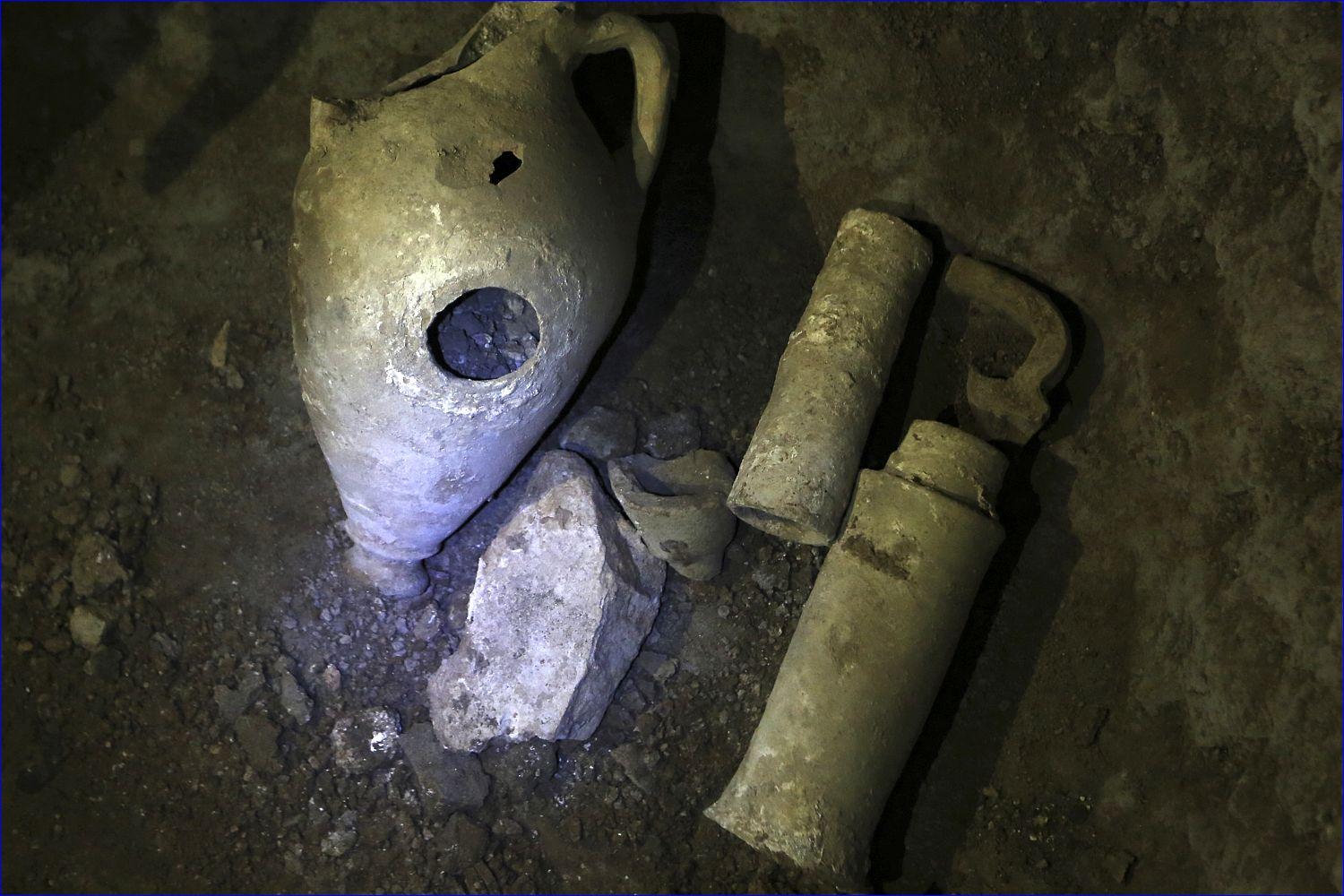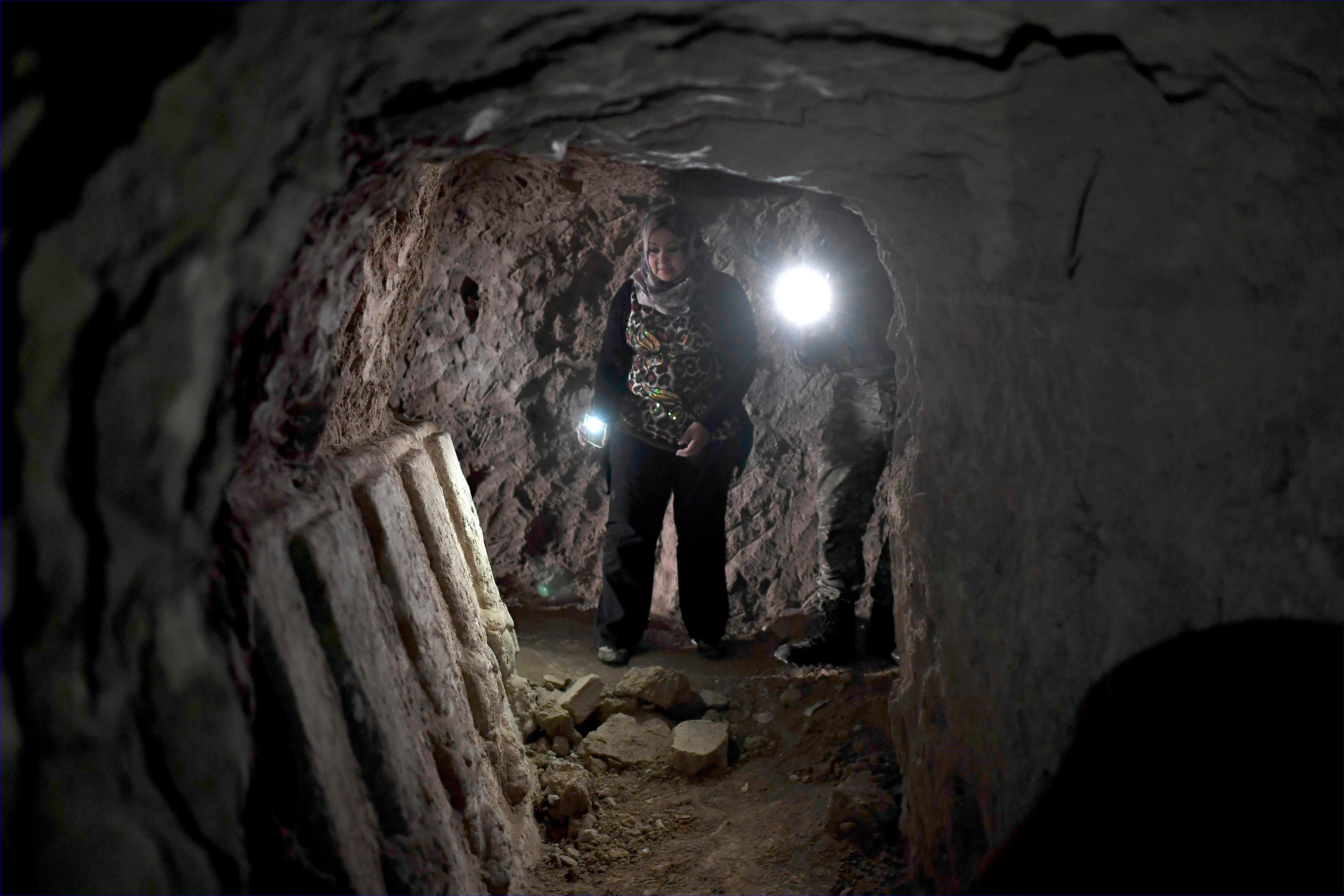


 Khalid Mohammed/AP)
Khalid Mohammed/AP)
Only thin stabs of torchlight guided our path as the earthen walls narrowed about our shoulders. Somehow pathetic in the bowels of this subterranean labyrinth, the torch nevertheless revealed much more than merely the earthen depths of yet another Islamic State tunnel.
Very soon, we discerned winged bulls and goddesses, cuneiform reliefs, bones and pottery and knew that we were stumbling not through an abandoned terrorist sanctuary but in the footsteps of ancient kings in a palace from the dawn of history.
Situated beneath the ruins of the tomb of Jonah in east Mosul among the remains of Nineveh -- one of the greatest and oldest cities in the world -- the unearthing last month of this Assyrian complex is the most significant archaeological find in Iraq's recent history, causing excitement and fear in academics across the world. The existence of the palace, which dates to 700 years before Christ, was known to specialists but it had never been excavated due to the sanctity of its location, better known as Nabi Yunus.
However, last month Iraqi archaeologists were led by locals to the mouth of a small tunnel beneath the rubble of Nabi Yunus, which had been blown up by Islamic State in June 2014 as part of its campaign to erase shrines from Iraq. The jihadists were driven from the area in January by advancing Iraqi troops in the battle to liberate the city.
"And this is what we found," said Layla Salih, 40, one of Iraq's pre- eminent archaeologists, as she gestured in the light of her mobile phone at two magnificent lamassu -- winged bulls -- on either side of the kilometre-long tunnel network.
"It is typical of the hypocrisy of the Daesh [Islamic State]," she explained, "that they destroy a site with explosive on video as they deem it un-Islamic, then dig beneath it to steal and sell the artefacts. But in a strange way it is the one positive thing to come out of all this. For their tunnelling for plunder has revealed a palace we would never have been allowed to excavate."
Though every moveable artefact has been taken away by Isis for sale on the international antiquities black market, the larger structures. including cuneiform reliefs and lamassu, have remained, as their extraction would have caused the tunnels to collapse.
The palace is believed to be that of the Assyrian King Esarhaddon (681-669 BC), youngest son of King Sennacherib, who expanded his royal quarters in Nineveh on an existing complex. Archaeologists had confirmed the site with official excavations around the perimeter of the palace gateway in 1952 and 1986.
The chaos in the wake of the US invasion of Iraq in 2003 halted all official excavations and in 2005 as the security situation in Mosul deteriorated, Iraqi authorities reburied the gateway to prevent looting.

 Aris Messinis/Getty Images)
Aris Messinis/Getty Images)
With mortar fire from the current battle with Isis going on overhead, Ms Salih located two huge alabaster lamassu, seven cuneiform reliefs of various sizes and three further reliefs portraying male and female figures. One, the first of its kind to be discovered in Nineveh, showed three female figures, most probably goddesses, in frontal study. Previous discoveries of Assyrian reliefs typically show figures in profile, and experts in ancient Assyrian artefacts and cuneiform readings say the frontal depiction and ancient script confirms the date of the palace to the reign of Esarhaddon.
"These frontal female figures are unusual," said Paul Collins, curator of ancient near east at the Ashmolean Museum of Art and Archaeology, Oxford, "but by mid-7th century BC you do start getting more unusual Assyrian reliefs and an interest in representing female deities, goddesses and supernatural figures. I have seen some of the photographs, and the cuneiform inscriptions confirm the site as the palace of Esarhaddon."
King Esarhaddon, whose father had sacked Babylon and slaughtered the city's inhabitants, boasting "with their corpses I filled the city squares", fought repeated wars throughout his rule and put his brothers' families to death. Aside from the muffled sounds of battle from Mosul's west bank above us as we explored the tunnels, other details within the underground complex echoed the violence of Esarhaddon's time in power.
Beside one junction, our torches illuminated stained orange jump suits used by Islamic State to dress their prisoners. In that lonely place a body rotted somewhere, and the stench of decay was overpowering.
"Could be a dead fighter, or a prisoner," Ms Salih explained. "We know the Daesh used their prisoners to dig these tunnels."
Elsewhere we came perilously close to falling down an ancient well shaft which suddenly gaped from the ground at our feet, its walls lined with cuneiform inscriptions. An Iraqi army officer leaned forward and dropped a stone down the shaft to assess its depth. We listened for the moment it landed at the bottom of the well, but the rock plunged into the depths of silence, and we jostled backwards, unnerved.
The site of the tunnel has been secured by Iraqi troops to prevent further looting, since Isis were driven from Mosul's east bank at the end of January. Now, the immediate concern for archaeologists is to document what lies in the tunnels, then support them from collapsing until the site can be properly examined.
In the recent report of her findings to Iraq's State Board of Antiquities and Heritage, Ms Salih noted that the tunnels could collapse "within weeks", an event which could destroy not only Esarhaddon's palace, but the shattered remnants of Jonah's tomb and the layers of heritage caked beneath it.
Unesco is in touch with Iraq's Ministry of Culture and experts from the British Institute for the Study of Iraq over the fate of the palace beneath Nabi Yunus, and a proposal has been sent to the Smithsonian Museum in the US for help in preserving the tunnels.
Yet the battle for Mosul continues and, until the guns fall silent in the ravaged city, work is unlikely to start on saving an underground palace still in sniper range of Isis positions on the west bank of the River Tigris. The secrets of King Esarhaddon may yet be surrendered back to the Nineveh earth.

or register to post a comment.